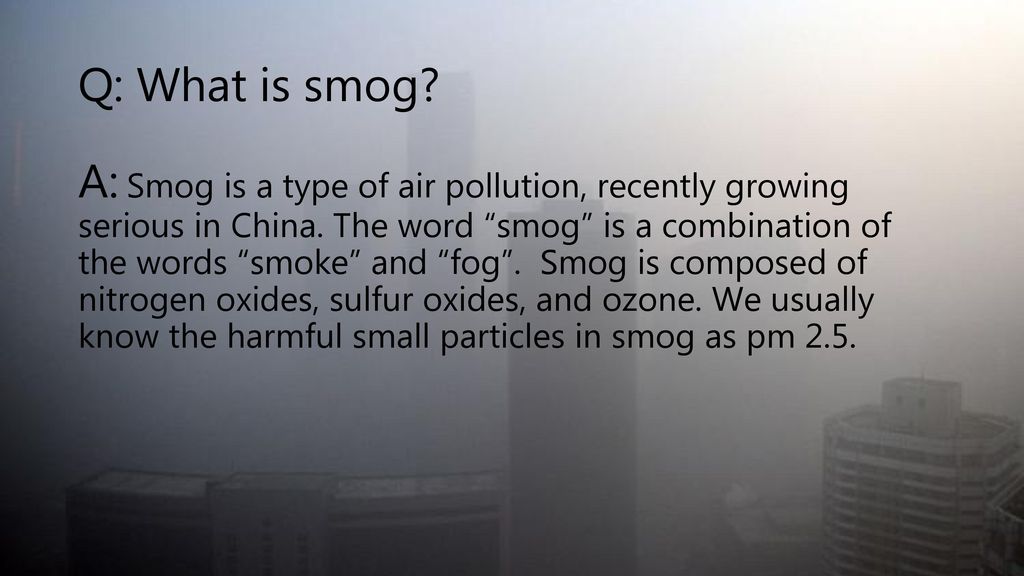mixture of solid and liquid fog and smoke particles formed when humidity is high and the air so calm that smoke and fumes accumulate near their source. Smog reduces natural visibility and often irritates the eyes and respiratory tract. In dense urban areas, the death rate usually goes up considerably during prolonged periods of smog, particularly when a process of heat inversion creates a smog-trapping ceiling over a city
Smog prevention requires control of smoke from furnaces; reduction of fumes from metal-working and other industrial plants; and control of noxious emissions from automobiles, trucks, and incinerators. In the U.S. internal-combustion engines are regarded as the largest contributors to the smog problem, emitting large amounts of contaminants, including unburned hydrocarbons and oxides of nitrogen. The number of undesirable components in smog, however, is considerable, and the proportions highly variable. They include ozone, sulfur dioxide, hydrogen cyanide, and hydrocarbons and their products formed by partial oxidation.
like it so thumb up plzzzz
thankyou
- 1
Smog is a kind of air pollution; the word "smog" is a portmanteau of smoke and fog. Classic smog results from large amounts of coal burning in an area caused by a mixture of smoke and sulfur dioxide. Modern smog does not usually come from coal but from vehicular and industrial emissions that are acted on in the atmosphere by sunlight to form secondary pollutants that also combine with the primary emissions to form photochemical smog.Smog is a problem in a number of cities and continues to harm human health.[2] Ground-level ozone, sulfur dioxide, nitrogen dioxide and carbon monoxide are especially harmful for senior citizens, children, and people with heart and lung conditions such as emphysema, bronchitis, and asthma[3]. It can inflame breathing passages, decrease the lungs' working capacity, cause shortness of breath, pain when inhaling deeply, wheezing, and coughing. It can cause eye and nose irritation and it dries out the protective membranes of the nose and throat and interferes with the body's ability to fight infection, increasing susceptibility to illness.PLEASE READ THIS IT IS IMPORTANT
- 1
- 0
mixture of solid and liquid fog and smoke particles formed when humidity is high and the air so calm that smoke and fumes accumulate near their source. Smog reduces natural visibility and often irritates the eyes and respiratory tract. In dense urban areas, the death rate usually goes up considerably during prolonged periods of smog, particularly when a process of heat inversion creates a smog-trapping ceiling over a city
Smog prevention requires control of smoke from furnaces; reduction of fumes from metal-working and other industrial plants; and control of noxious emissions from automobiles, trucks, and incinerators. In the U.S. internal-combustion engines are regarded as the largest contributors to the smog problem, emitting large amounts of contaminants, including unburned hydrocarbons and oxides of nitrogen. The number of undesirable components in smog, however, is considerable, and the proportions highly variable. They include ozone, sulfur dioxide, hydrogen cyanide, and hydrocarbons and their products formed by partial oxidation.
hope this will help u
thumbs up plzzzzzzzzzzz
- 0
Smogis a type ofair pollution. The word "smog" was made in the early 20th century as aportmanteauof the wordssmokeandfogto refer to smoky fog.[1]The word was then intended to refer to what was sometimes known aspea soup fog, a familiar and serious problem inLondonfrom the 19th century to the mid 20th century. This kind of smog is caused by the burning of large amounts ofcoalwithin a city; this smog containssootparticulatesfromsmoke,sulfur dioxideand other components
Smog usually forms in industrial areas or areas of high population, which release large amounts ofair pollution, such as smoke or gases.
It can inflame breathing passages, decrease the lungs' working capacity, cause shortness of breath, pain when inhaling deeply, wheezing, and coughing. It can cause eye and nose irritation and it dries out the protective membranes of the nose and throat and interferes with the body's ability to fight infection, increasing susceptibility to illness
- 0
CAUSES- Photochemical smog is the chemical reaction of sunlight, nitrogen oxides and volatile organic compounds in the atmosphere, which leaves airborne particles and ground-level ozone. This noxious mixture of air pollutants may include the following: Aldehydes.
EFFECTS- Coughing and throat or chest irritation: High levels of ozone can irritate your respiratory system, generally lasting for a few hours after you've been exposed to smog. However, ozone can continue to harm your lungs even after symptoms disappear. This is because of the effects of ozone on lung function.
- -1
- 0
- 1

- Smog is made up of a combination of air pollutants that can compromise human health, harm the environment, and even cause property damage.
- Smog can cause or aggravate health problems such as asthma, emphysema, chronic bronchitis and other respiratory problems as well as eye irritation and reduced resistance to colds and lung infections.
- The ozone in smog also inhibits plant growth and can cause widespread damage to crops and forests.

- 1

